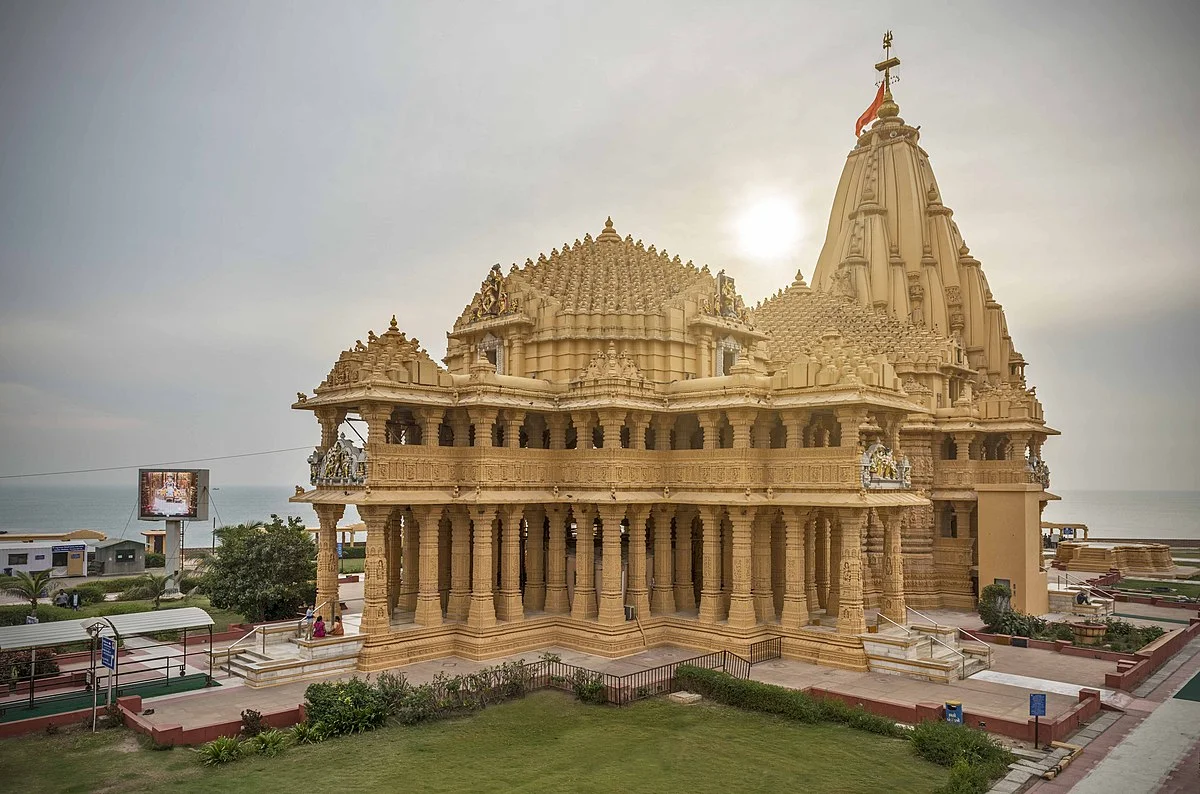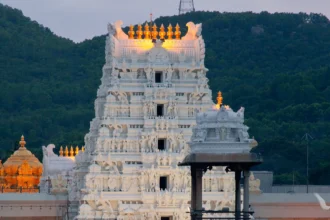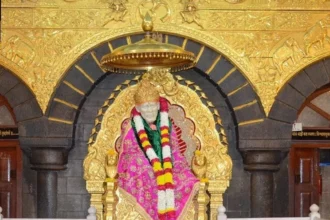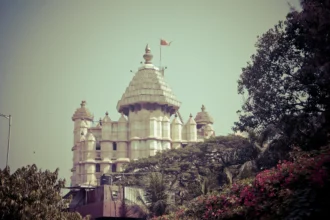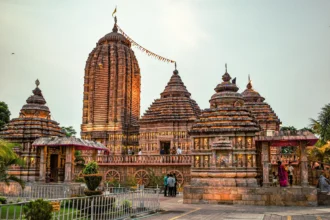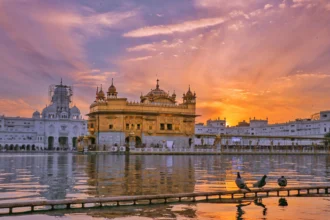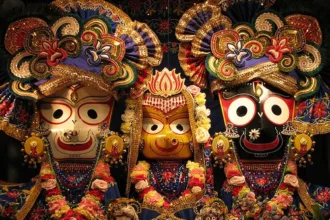A Sanctuary Reborn: The Legacy of Somnath Temple
Situated by the Arabian Sea in Prabhas Patan, Gujarat, Somnath Temple is the first among India’s revered twelve Jyotirlingas and a timeless symbol of spiritual devotion and cultural resurgence. With a legacy of being destroyed and rebuilt at least 17 times, its present glory began with reconstruction initiated by Sardar Vallabhbhai Patel, and was consecrated in 1951. Somnath—meaning “Lord of the Moon”—stands today as a testament to India’s enduring identity.
Architecture, Anchored in Symbolism
- The temple is crafted in the Chalukya–Solanki style, fusing Nagara and Dravidian architecture, with an imposing Shikhara (spire) rising to 155 ft, crowned with a 10-ton Kalash, and a 27-ft Dhwaj Stambha (flagpole).
- Inside, the Sabha Mandap’s 56 pillars are intricately carved with scenes from Shaivite lore and Vedic philosophy.
()
Major Developments: From Temple to Smart Pilgrimage Hub
Vande Bharat Express: Ahmedabad to Somnath in 7 Hours

On May 26, 2025, Prime Minister Modi inaugurated the Sabarmati–Veraval Vande Bharat Express, cutting travel time from Ahmedabad to Somnath to just seven hours—seamless, speedy, and pilgrim-friendly.
Urban Makeover: Rs 282 Crore Master Plan
Under the newly formed Somnath Urban Development Authority (SUDA), the temple and surrounding areas are undergoing a Rs 282 crore transformation. This includes coastline promenades, heritage exhibitions, eco-village haats, museum galleries, and more—all honoring the blend of culture and modern tourism.
Pilgrimage Infrastructure Revamp
As part of the PRASHAD initiative, heritage walks, exhibitions, and a 1.48‑km Somnath Promenade along the sea have been completed at a cost of Rs 47 crore. New museum displays include dismantled parts from earlier temple versions, preserving layers of history.
Somnath Festival 2025: Celebrating Faith Through Art
Held during Mahashivratri from Feb 24–26 2025, the Somnath Festival brought together spiritual discourse and cultural performance under the theme “Kala Dwara Aaradhana”. Highlights included:
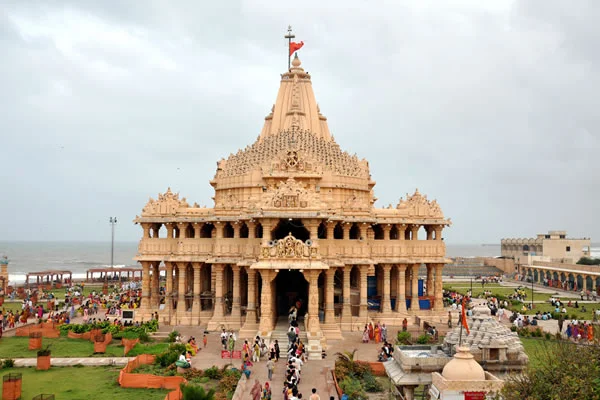
- Sagar Aarti by the sea at sunset
- Seminars titled Somnath: Temple, Tirtha & Tradition
- Musical exhibitions like “Vādyam‑Nādasya Yātrā”
- Performances by Padma awardees and a commemorative 108-lamp ritual at the Triveni Sangam
Visiting Somnath: Practical Tips & Pilgrim Resources
Visiting Hours & Rituals
- Open daily from 6 AM to 9:30 PM
- Key ceremonies:
- Mangla Aarti: ~7 AM
- Sandhya Aarti: ~7 PM
- Optional VIP Darshan: Sheegra, Mukhamandapa, Antaraalaya services available with online booking.
Accommodation
- Stay in trust-run facilities such as Sagar Darshan, Lilavati Atithi Bhavan, dormitories and VIP lodges.
- Government-built new circuit house offers deluxe lodging and banquet halls.
How to Reach
- By Train: Nearest is Veraval Station (~5 km). Daily services include the new Vande Bharat Express from Ahmedabad.
- By Road: Well-connected via state highways. Nearest airport: Diu (~95 km).
- By Air: Flights land at Diu and onward road travel is available.
Security & Entry Policy
Strict restrictions exist: electronics, leather belts, and watches are not allowed. Lockers are available for a nominal fee. Pilgrims often share useful tips on queue protocols and eligibility for special darshan, especially for seniors.
Nearby Attractions Worth Exploring
- Triveni Sangam: Confluence of Hiran, Kapila, and mythical Sarasvati rivers
- Bhalka Tirth: Krishna’s final resting place, just 4 km away
- Girnar Hills & Devalia Wildlife Sanctuary: Nature excursions nearby
- Prabhas Patan Museum, Panch Pandav Caves, Gita Mandir: Rich in history and spiritual insights
Symbolism That Transcends Time
- Known as the beginning of the Jyotirlinga trail, Somnath is central to many pilgrims’ spiritual journeys across India.
- Chief Minister Bhupendra Patel noted that Somnath embodies modern India’s identity and the “Ek Bharat, Shrestha Bharat” vision.
- Literary and cultural creations like K.M. Munshi’s Jai Somnath continue to celebrate its legacy.
Why Somnath Temple Is a Modern Heritage Powerhouse
- Blending faith with futuristic infrastructure: Express trains, promenades, museums—all serving pilgrims.
- Cultural reawakening: Dance, music, and seminars celebrate its ancient link to Nāṭya and Gāna.
- Tourism destination: Seamless connectivity and robust guest facilities now set the stage for world-class pilgrimage tourism.
- Responsible development: SUDA’s plan balances modernization with spiritual and ecological integrity.
Final Reflections
Somnath Temple is more than a shrine, it is a chronicle of devotion, destruction, and divine return. With upgraded access, enriched culture, and digital infrastructure, it beckons modern pilgrims to experience spirituality with ease and reverence.
Whether you’re here to witness Maha Aarti, explore coastal heritage, or walk a sacred seashore at sunset, Somnath offers more than darshan, it offers timeless meaning.

